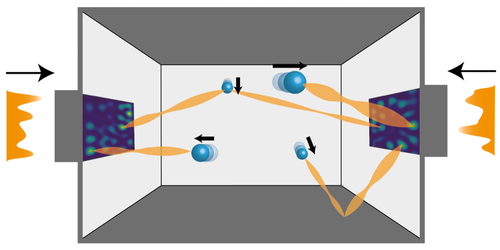Freezing Particle Motion with a Matrix
When light travels through an environment containing many particles, information about the collective motion of the particles gets added to the light. This information leaves a measurable signature on a quantity known as the scattering matrix. Now researchers from the Vienna University of Technology predict that the information in this matrix could be used to alter the speeds of the particles [1, 2]. The team says that, if experimentally realized, the technique could allow scientists to study the collective quantum behavior of more particles than is possible with current techniques.
Researchers have long been fascinated with using light to slow down or even freeze the motion of a collection of particles. One motivation is that cooled particles can be isolated from outside influences in order to study quantum behaviors such as entanglement. To date, researchers have simultaneously cooled one or two particles, but they have struggled to scale techniques to cool additional particles.
In their proposed method, Stefan Rotter and his colleagues monitor the collective motion of an ensemble of particles via the scattering matrix. This matrix is then fed back into the laser system to create a real-time cooling pattern that manipulates the particles’ speeds. While this approach supplies no information about the locations and movements of individual particles, the team predicts that it does contain the information necessary to cool the whole system.
The team applied the scheme to simulated systems of up to forty-five 150-nm-diameter silica beads. Experimental verification of the technique is underway. “What amazes us about our findings is that they show how little information is actually necessary to efficiently cool a collection of particles,” Rotter says.
–Erin Knutson
Erin Knutson is an Associate Editor for Physical Review A.
References
- J. Hüpfl et al., “Optimal cooling of multiple levitated particles through far-field wavefront shaping,” Phys. Rev. Lett. 130, 083203 (2023).
- J. Hüpfl et al., “Optimal cooling of multiple levitated particles: Theory of far-field wavefront shaping,” Phys. Rev. A 107, 023112 (2023).




